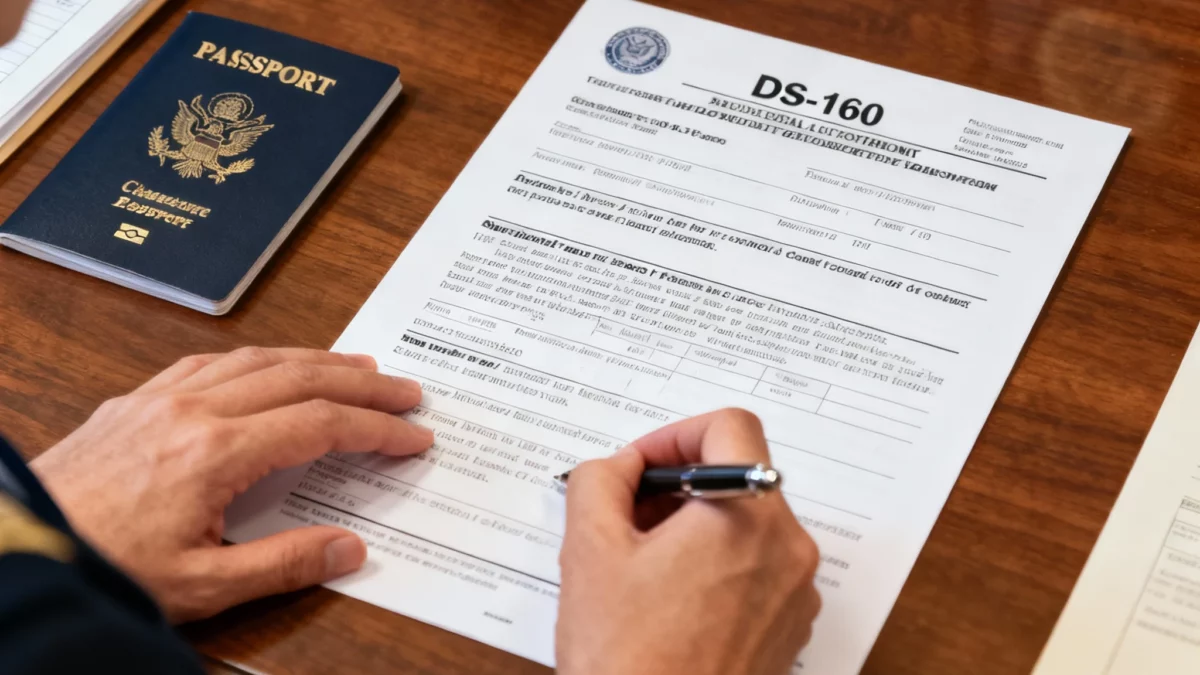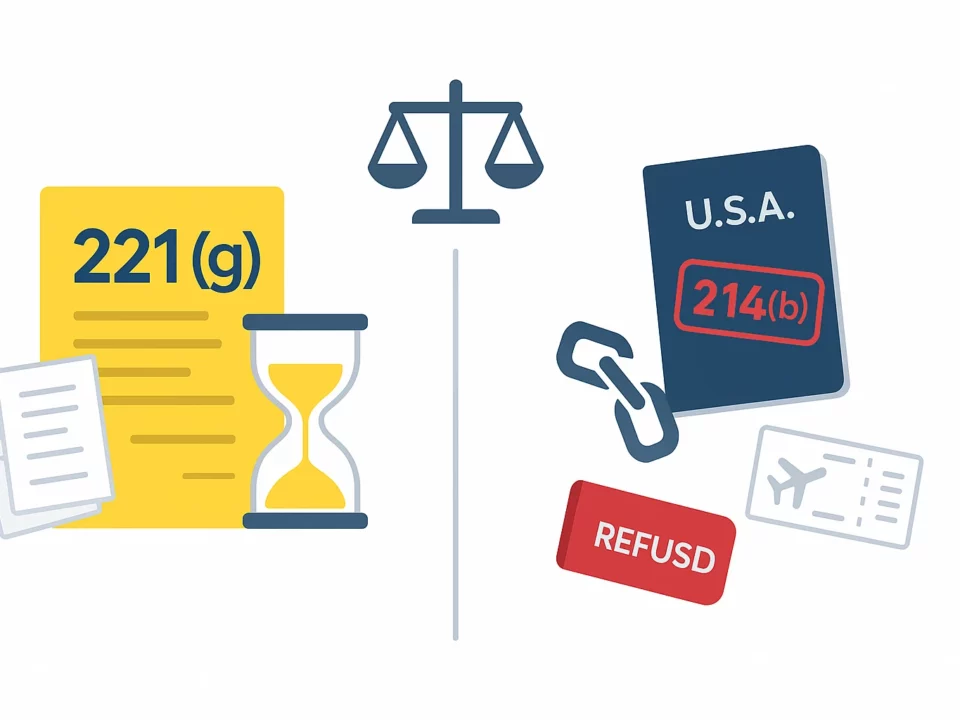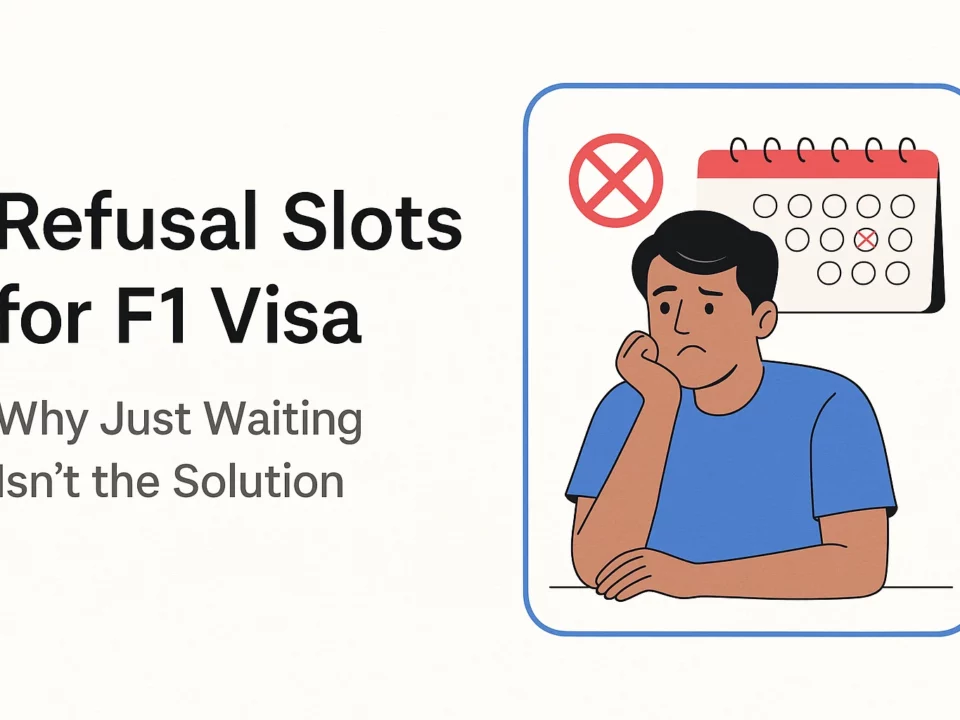DS-160 Form Guide 2026: Former Officer Reveals Secret

Your DS-160 form isn’t just paperwork. It’s the foundation of your entire F1 visa outcome – and most applicants have no idea what they actually submitted
Estimated reading time: 12 minutes
When we ask students what they wrote in their DS-160 form, particularly in the open-ended narrative sections, most pause. Then they admit their agent filled it out for them. Some haven’t even read what was submitted under their name.
Table of contents
- The DS-160 Myth: Why Agents Minimize Its Importance
- What Visa Officers ACTUALLY Read in Your DS-160
- DS-160 and Interview: How They Work Together
- Common DS-160 Mistakes That Lead to Refusals
- Narrative Crafting: Building Your DS-160 Foundation
- Red Flags Officers Spot Immediately in DS-160
- How to Write Your DS-160: The Bluehawks Method
- Your DS-160 Preparation with Bluehawks EduAbroad
- The Bottom Line: Own Your DS-160
This moment, repeated hundreds of times across our team, revealed something critical: the DS-160 form is systematically underestimated by both applicants and many consulting agents, yet it remains one of the most important documents determining your F1 visa outcome.
At Bluehawks EduAbroad, our former U.S. consular officers understand exactly what happens when your DS-160 reaches the interview desk. Today, we’re sharing the complete truth about the DS-160 form – what officers actually read, what triggers concerns, and how to craft narratives that support rather than undermine your visa approval.
The DS-160 Myth: Why Agents Minimize Its Importance
For years, a particular consulting model has dominated India’s visa consulting landscape. The approach is simple: collect documents from students, have agents fill out forms quickly, and move forward. The philosophy underlying this model treats the DS-160 as administrative paperwork rather than strategic communication.
Consequently, students are told to write minimal information in DS-160 text boxes. They hear phrases like “keep it short,” “don’t over-explain,” or “the form doesn’t matter much.” This advice persists despite being fundamentally outdated and increasingly dangerous.
Why Agents Perpetuate This Myth:
The reason is structural. High-volume consulting models require speed. Processing fifty DS-160 forms with minimal student input is more efficient than guiding each applicant through thoughtful narrative development. Therefore, agents minimize the DS-160 to maximize throughput.
Additionally, when applications go smoothly, agents never hear feedback. Consequently, they maintain the same approach even as visa requirements tighten. Only when students face multiple refusals do they discover the truth: their DS-160 was inadequate.
The Reality Check: When visa rules tightened significantly in 2024-2025, many agents’ unsustainable models were exposed. Students applying through these services faced unprecedented refusal rates because the minimal DS-160 approach no longer worked in an environment demanding clear, consistent narratives.
What Visa Officers ACTUALLY Read in Your DS-160
Our team of former consular officers can tell you exactly what happens when your DS-160 arrives at the interview desk.
The First Few Minutes: Officers scan your entire DS-160 form looking for consistency. They’re not reading carefully yet – they’re checking for obvious red flags. Consequently, contradictions between sections, missing information, or generic responses immediately trigger concerns.
The ‘Current Duties’ Section’: This is where most applications fail or succeed. Officers read your response with specific attention to:
- Clarity of expression: Can you articulate your situation coherently?
- Specificity vs. generics: Are you providing concrete details or copying template responses?
- Logical coherence: Does your educational goal make sense given your background and experience?
- Authenticity signals: Do your answers sound genuinely yours or coached?
The Background Check: Officers cross-reference your DS-160 with available databases and social media. Consequently, inconsistencies between what you claim and what they discover online create credibility deficits that are nearly impossible to overcome in the interview.
The Interview Preparation: Before your interview, the officer reads your complete DS-160 multiple times. They’re preparing questions targeting any ambiguities or concerns. Therefore, vague DS-160 responses guarantee difficult interview questions.
The Decision Point: Your DS-160 establishes the baseline for officer assumptions. Strong narratives create presumptions of truthfulness requiring you to prove otherwise. Weak narratives create presumptions of deception requiring you to prove your credibility – a much harder position.
DS-160 and Interview: How They Work Together
Many applicants treat DS-160 and interview as separate events. This is fundamentally incorrect. They are integrated components of a single evaluation process.
How Officers Use DS-160 During Interview:
First, officers typically have your DS-160 visible during the interview. Consequently, they reference it constantly. Second, they ask follow-up questions about statements you made in DS-160. Third, they assess whether your verbal responses match written claims. Fourth, they probe ambiguities or gaps they identified reading your form.
The Narrative Continuity Requirement: Your DS-160 narrative establishes the story you’ll defend in the interview. If that story is weak, generic, or inconsistent, your interview becomes defensive rather than confirmatory. Additionally, crafting a strong interview narrative is exponentially harder when your DS-160 foundation is weak.
Real Refusal Pattern: Students come to us after refusals reporting that the officer repeatedly referenced their DS-160. Consequently, they were asked to clarify or expand on responses they wrote months earlier. When they couldn’t remember what they wrote or what they meant, officer confidence collapsed.
The Critical Insight: Your DS-160 should be written by YOU, in YOUR words, with YOUR understanding of what you’ve committed to. This creates authentic, consistent responses that withstand interview scrutiny. Conversely, forms written by agents create gaps between what applicants know and what they claimed.
Common DS-160 Mistakes That Lead to Refusals
Based on analyzing hundreds of refusals, we’ve identified recurring DS-160 mistakes that create predictable rejections.
Mistake 1: Generic Career Narratives
The Error: Writing generic statements like “I want to contribute to India’s development” or “I aim to gain skills to advance my career.”
Why Officers Reject This: These statements could apply to anyone. Officers immediately recognize them as template language rather than genuine personal narrative. Consequently, they suspect coaching and lose confidence in your authenticity.
Correct Approach: Specific details about your actual situation. For example: “My current role at XYZ company involves supply chain management for the textile export sector. However, the company is expanding into sustainable materials requiring knowledge of U.S.-standard quality controls and environmental certifications. This specific program teaches exactly these competencies, enabling me to lead our quality transformation when I return.”
Mistake 2: Inconsistent Timelines or Career Logic
The Error: Claiming educational goals that don’t align with your background or trajectory. For example, working in finance but suddenly claiming you want to study agriculture without explanation.
Why Officers Reject This: Inconsistent narratives suggest you haven’t thought through your plans. Furthermore, sudden career pivots without explanation raise questions about true motivations.
Correct Approach: Logical narrative connecting your background, current situation, and educational goals. If there is a pivot, explain why the change makes sense.
Mistake 3: Vague Family and Home Ties
The Error: Minimal information about family, property, or obligations in India. Consequently, officers cannot assess your home country commitments.
Why Officers Reject This: Weak home ties suggest weaker motivation to return. Furthermore, vagueness prevents officers from building confidence in your temporary intent.
Correct Approach: Specific details about family roles, property ownership, family business involvement, and obligations. For example: “My father operates a 15-person software services firm founded in 1998. I’m currently Director of Operations but lack formal training in business management and financial systems. Additionally, my mother requires ongoing medical care – I’m her primary support as her eldest son.”
Mistake 4: Minimal Financial Explanation
The Error: Providing minimal context about who funds education, why, and how it’s financially sustainable.
Why Officers Reject This: Unclear funding creates concerns about work authorization intentions. Additionally, missing explanations suggest you haven’t prepared your financial story.
Correct Approach: Clear explanation of funding sources, sponsor relationship, and financial capacity. For example: “My father sponsors my education through his company’s funds. Our family property is valued at ₹2.5 crores held for three generations. Additionally, I have personal savings of ₹15 lakhs from my salary.”
Mistake 5: Overwriting or Defensive Tone
The Error: Providing excessively long explanations or defensive responses trying to preempt officer concerns.
Why Officers Reject This: Excessive length suggests you’re trying to hide something. Defensive tone suggests guilty conscience. Consequently, officers become more suspicious.
Correct Approach: Concise, clear, confident statements providing necessary information without over-explanation.
Mistake 6: Copied or Templated Responses
The Error: Using consulting agent templates or copying responses from online forums.
Why Officers Reject This: Experienced officers recognize template language instantly. Consequently, they immediately suspect your authenticity and preparation.
Correct Approach: Write in your own voice, addressing your specific situation. Your genuine voice is your greatest asset.
Mistake 7: Missing or Vague Current Responsibilities
The Error: Not clearly explaining your current job duties or educational background.
Why Officers Reject This: Without understanding your current situation, officers cannot assess whether your educational plan makes sense. Consequently, they assume you haven’t thought it through.
Correct Approach: Clear explanation of current role responsibilities. For example: “As Senior Developer at TCS, I lead a team of four engineers developing mobile applications. My responsibilities include architecture design, code review, and client interaction. However, I lack formal training in distributed systems and cloud infrastructure, which are increasingly required for advancement in my company.”
Narrative Crafting: Building Your DS-160 Foundation
Your DS-160 open-ended responses should tell a coherent story answering the fundamental question every officer asks: “Why does this person deserve a student visa, and will they actually return to India?”
The Five-Part Narrative Structure:
Part 1 – Your Current Situation (2-3 sentences)
Explain your current role, responsibilities, and why you’re in this position. Be specific and concrete. Example: “I currently work as a Data Analyst at Flipkart’s supply chain division, analyzing logistics optimization. My team of three analysts supports decision-making for ₹500+ crore logistics operations. I’ve been in this role for two years.”
Part 2 – The Gap (2-3 sentences)
Identify what you need that your current situation doesn’t provide. Be specific about skill gaps or knowledge deficits. Example: “While my analytical skills are strong, I lack formal training in advanced statistical modeling and predictive analytics using Python. Additionally, I have no exposure to machine learning applications in logistics optimization. These skills are increasingly required for advancement in my company.”
Part 3 – Why U.S. Education (2-3 sentences)
Explain why U.S. education specifically addresses your gap. Don’t just say “U.S. education is good.” Explain what makes U.S. education specifically valuable. Example: “The University of Washington’s graduate program in Data Science has specific courses in supply chain predictive analytics taught by faculty with industry experience. Additionally, internship opportunities with major logistics companies provide practical experience I cannot access in India.”
Part 4 – Your Post-Education Plan (2-3 sentences)
Explain specifically what you’ll do after graduation. Be concrete about roles, companies, or ventures. Example: “After completing my degree, I plan to return to Flipkart with my new skills, applying predictive analytics to optimize our logistics costs by 10-15%. Additionally, I’m exploring launching a logistics optimization consulting practice serving mid-size e-commerce companies.”
Part 5 – Your Ties to India (2-3 sentences)
Explain why you’ll return to India. Reference family, property, career, or business interests. Example: “My parents depend on me. Additionally, my family owns property valued at ₹1.5 crores in Bangalore where three generations have lived. Finally, my career progression requires India presence – U.S. work authorization is neither necessary nor desired.”
Red Flags Officers Spot Immediately in DS-160
Certain patterns in DS-160 responses trigger automatic officer skepticism:
🚩 Red Flag #1: Generic Statements
“I want to pursue higher education” or “I aim to achieve excellence” – these could apply to anyone. Officers immediately recognize them as unthoughtful.
🚩 Red Flag #2: Unexplained Career Pivots
Sudden, unexplained changes in career direction without logical connection. Officers question whether you’ve actually thought through your goals.
🚩 Red Flag #3: Weak Home Ties
Minimal information about family, property, or career in India. Officers assume weak ties suggest weak motivation to return.
🚩 Red Flag #4: Vague Financial Explanations
Missing details about funding sources or sponsor capacity. Officers question financial sustainability and suspect work motivation.
🚩 Red Flag #5: Template Language
Phrases officers have heard hundreds of times. Officers immediately recognize unoriginal responses as coached rather than genuine.
🚩 Red Flag #6: Defensive Tone
Over-explaining or anticipating officer concerns. Defensive writing suggests guilty conscience. Officers become more suspicious, not less.
🚩 Red Flag #7: Inconsistency with Documents
DS-160 claims contradicting university letter, financial documents, or work history. Officers verify information and lose confidence immediately when discrepancies appear.
🚩 Red Flag #8: Missing Key Details
Not explaining current role, educational background, or family situation clearly. Officers cannot assess your situation and make conservative (negative) assumptions.
🚩 Red Flag #9: Unrealistic Plans
Post-education plans that don’t align with your education or background. Officers question whether you’re being truthful or delusional about your prospects.
🚩 Red Flag #10: Sign of Agent Involvement
Responses that don’t sound like they came from you – overly formal language, phrases that don’t match your background, or responses that don’t address your actual situation.
How to Write Your DS-160: The Bluehawks Method
Step 1: Prepare Before Touching the Form (1 Week)
Write your narrative story offline. Don’t touch the actual DS-160 form yet. Instead, draft your response to each key question in a Word document. Furthermore, read your draft multiple times. Does it sound like you? Are there inconsistencies? Does it answer the officer’s core questions?
Step 2: Get Feedback (2-3 Days)
Have someone you trust review your narrative. Can they understand your situation? Does it make logical sense? Would they be convinced by your story?
Step 3: Complete the Actual DS-160 Form (1 Day)
Once your narrative is solid, complete the official form. Copy-paste your prepared responses into the appropriate fields. Review everything multiple times. Correct any errors or typos.
Step 4: Final Verification (1 Day)
Print your completed DS-160 (if possible through your account) and review it as if you were the visa officer. Do all sections make sense together? Are there gaps? Do responses support each other logically?
Step 5: Submit and Prepare for Interview (Ongoing)
After submission, prepare for interview questions about everything you wrote. Be ready to expand, explain, and defend every statement.
Your DS-160 Preparation with Bluehawks EduAbroad
Understanding DS-160’s importance is one thing. Actually crafting a compelling narrative is another. At Bluehawks EduAbroad, our former consular officers provide specialized DS-160 guidance that transforms this critical document from administrative burden to strategic asset.
DS-160 Narrative Coaching Program:
Complete Narrative Development:
- Your specific situation analysis and narrative strategy
- Personalized guidance on addressing officer concerns
- Detailed section-by-section completion strategy
- Review and refinement of your actual DS-160 draft
Consistency Verification:
- Ensuring DS-160 aligns with all supporting documents
- Cross-checking for internal inconsistencies
- Verification against social media and online presence
- Interview question preparation based on your DS-160
Interview Bridge Building:
- Preparing how to verbally expand on DS-160 responses
- Anticipating officer follow-up questions
- Building confidence in defending your written narrative
- F1 Visa Mock interviews testing consistency between DS-160 and verbal responses
The Bottom Line: Own Your DS-160
Your DS-160 is not paperwork to delegate to an agent. It is your written testimony to a U.S. consular officer about who you are, what you want, and why you deserve a student visa.
Own it. Write it yourself. Make it reflect your genuine situation, authentic voice, and thoughtful planning. When you do, your DS-160 becomes not a liability but an asset – a document that builds officer confidence rather than triggering skepticism.
The difference between refusal and approval often comes down to exactly this: a DS-160 written thoughtfully by you versus one filled hastily by someone else.
💬 Chat with our 24/7 chat support team, just tap on that WhatsApp button on the right bottom of your screen 👉



